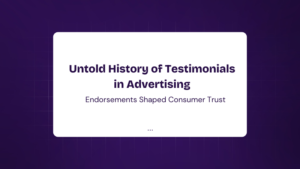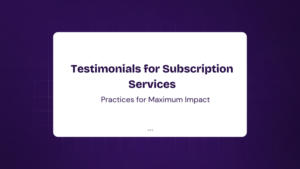The Art of the Testimonial—More Than Just Flattery
Let’s face it—no one believes a business that says, “We are the best!” But when a real customer says, “This changed my life!”—suddenly, everyone listens.
That’s the magic of testimonials. They transform skeptical prospects into paying customers faster than a 50% off sale. But here’s the catch: not all testimonials are created equal. Some are persuasive, others are forgettable, and a few are downright cringeworthy.
So, how do you master the testimonial technique? What questions should you ask for impactful testimonials? How can you adapt a testimony for different audiences? And what types of testimonials work best? Buckle up—we’re about to dive deep into the science of social proof.
What Is the Testimonial Technique?
The testimonial technique is the strategic use of customer feedback to build credibility, boost conversions, and influence buying decisions. It’s a form of social proof, a psychological phenomenon where people assume that others’ choices are the correct ones.
Why Do Testimonials Work?
According to a BrightLocal survey, 88% of consumers trust online reviews as much as personal recommendations. Another study by Spiegel Research Center found that displaying reviews can increase conversion rates by 270%. That’s huge!
The Anatomy of a Persuasive Testimonial
A good testimonial isn’t just a generic “This product is great!” It has:
✔ Authenticity – Real words from a real person
✔ Specificity – Concrete details about the experience
✔ Transformation – A clear before-and-after story
For example, compare these two testimonials:
❌ “This software is amazing! Highly recommend.”
✅ “Before using XYZ Software, our team wasted hours on manual data entry. Now, we save 15+ hours a week and have cut errors by 40%. It’s a game-changer!”
The second one wins—hands down.
What Questions to Ask for Better Testimonials?
Getting a great testimonial is all about asking the right questions. If you simply ask, “Can you leave a review?”, you’ll likely get something vague. Instead, guide your customers with these smart questions:
1. What problem were you facing before using our product/service?
This helps highlight the pain point your product solves.
2. What made you choose us over competitors?
This showcases your unique value.
3. How has your experience been so far?
This encourages an honest, detailed response.
4. Can you share a specific result or improvement?
Data-driven testimonials (e.g., “Our sales increased by 30%”) are more persuasive.
5. Would you recommend us to others? Why?
This helps reinforce social proof.
By framing your questions well, you’ll get testimonials that are detailed, emotional, and conversion-focused.
How to Adapt a Testimony for a Different Audience?
Testimonials aren’t one-size-fits-all. A message that resonates with tech-savvy millennials may not work for corporate executives. The key is customization.
1. Adjust the Tone
- For a professional audience → Use formal language.
- For a younger audience → Keep it casual and relatable.
2. Highlight Relevant Benefits
- If targeting small businesses → Emphasize cost savings and efficiency.
- If targeting enterprises → Focus on scalability and security.
3. Modify the Format
- Social media ads? Short, catchy snippets.
- Website landing page? Longer, detailed testimonials with a customer photo.
- Sales presentations? Video testimonials work best.
Example: Same Testimonial, Different Audiences
🟢 For Entrepreneurs:
“I cut my admin time by 40%, allowing me to focus on growing my business.”
🟢 For Large Companies:
“Our team reduced operational inefficiencies by 40%, optimizing workflow across departments.”
Same impact, different phrasing.
What Are the Different Types of Testimonials?
There’s more than one way to showcase a testimonial. Here are the most effective formats:
1. Quote Testimonials (Most Common)
Short, text-based quotes from customers.
✅ Best for: Websites, brochures, and social media.
✅ Example: “XYZ Software transformed our workflow—our productivity soared by 50%!”
2. Video Testimonials (Most Persuasive)
Real customers on camera sharing their success story.
✅ Best for: Sales pages, YouTube, and ads.
✅ Example: A client explaining how your product saved their business.
3. Case Studies (Most Detailed)
Long-form stories detailing a customer’s journey with real data.
✅ Best for: B2B marketing, whitepapers, and sales meetings.
✅ Example: “By implementing ABC Solution, Company X cut costs by $100K annually.”
4. Influencer & Celebrity Endorsements
Testimonials from well-known figures in the industry.
✅ Best for: Brand credibility and PR campaigns.
✅ Example: Elon Musk tweeting about a new AI tool.
5. Social Media & UGC (User-Generated Content)
Organic posts, tweets, or reviews from real customers.
✅ Best for: Instagram, Twitter, and TikTok marketing.
✅ Example: A customer posting a before-and-after photo of their results.
Each type serves a purpose—choosing the right one depends on your audience and goals.
FAQs
How do I ask customers for a testimonial without being pushy?
Make it easy! Offer an incentive (like a discount or a feature highlight) and keep the process simple with guided questions.
Can I edit a customer’s testimonial?
You can polish grammar and clarity, but always get approval before altering the message.
Should I use real names and photos in testimonials?
Yes! It adds authenticity. If privacy is a concern, use initials or a first name only.
What’s better—written or video testimonials?
Video testimonials are more persuasive, but written ones are easier to display across multiple platforms.
Where should I showcase my testimonials?
On your website (homepage, landing pages), social media, emails, and sales materials.
Final Thoughts: Testimonials Are Your Best Salespeople
At the end of the day, testimonials aren’t just “nice-to-haves”—they’re essential. A powerful testimonial can:
✔ Boost trust and credibility
✔ Increase conversions and sales
✔ Strengthen your brand reputation
So, start collecting and strategically using testimonials today. Your future customers are waiting for proof that you’re the real deal!



